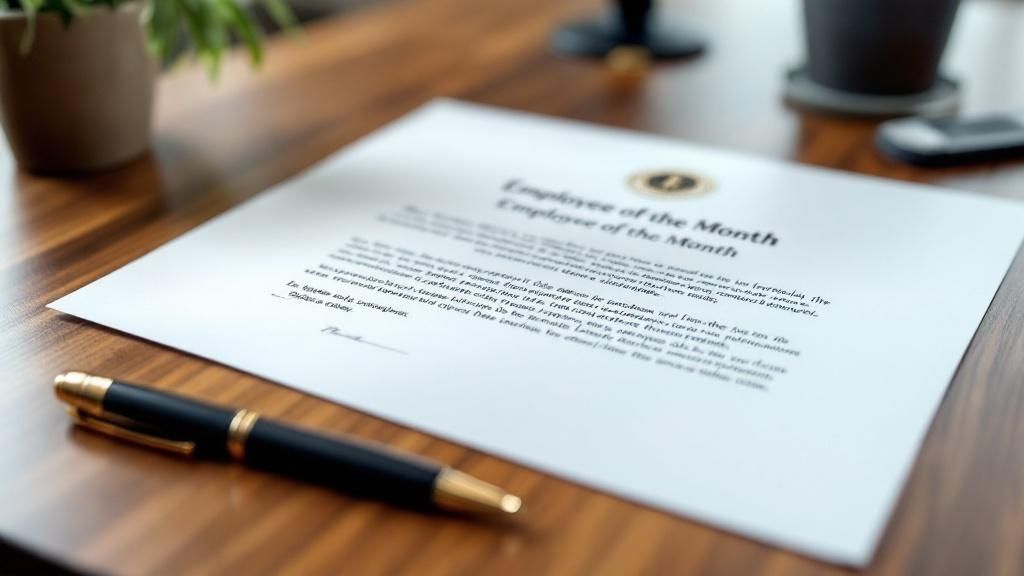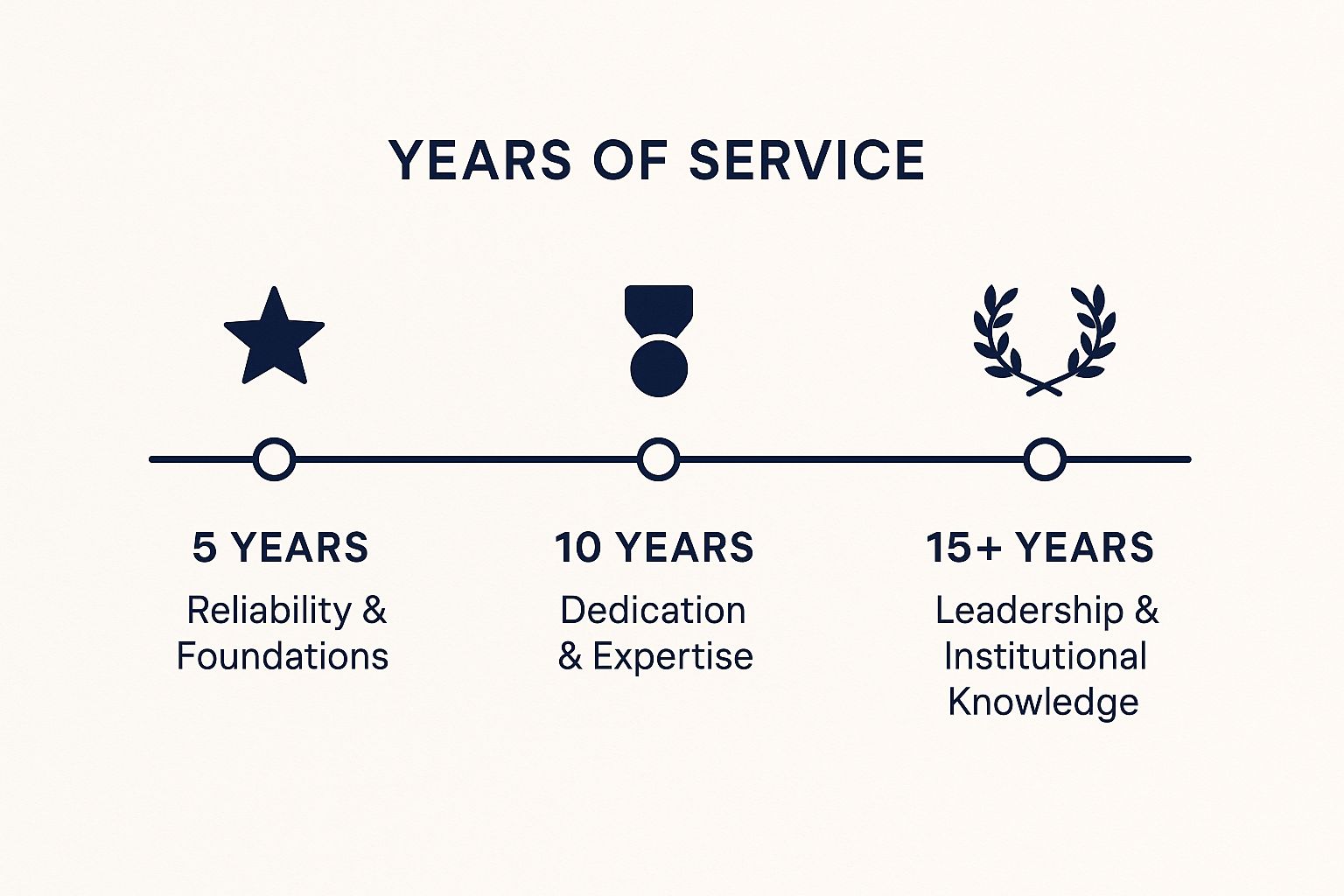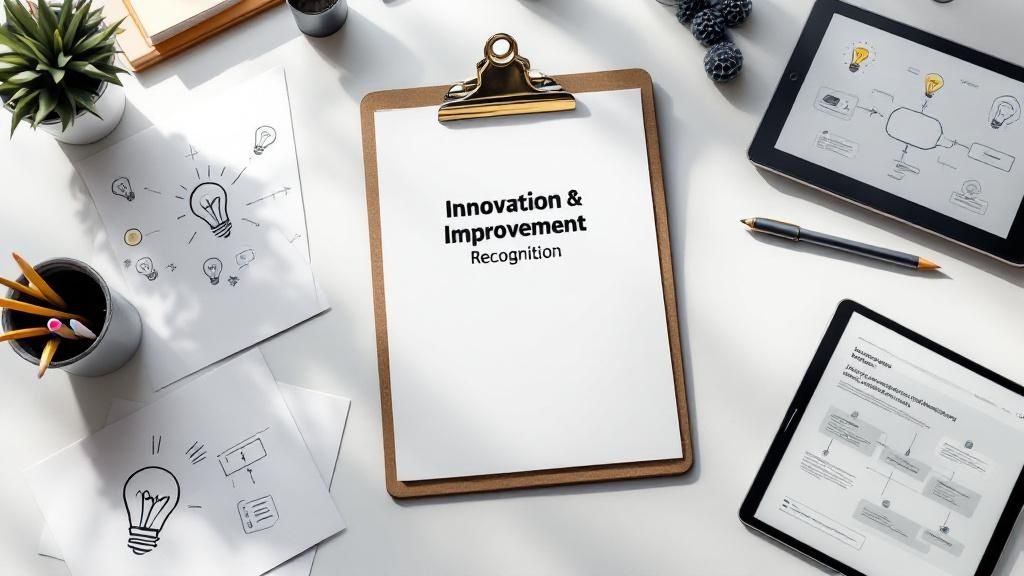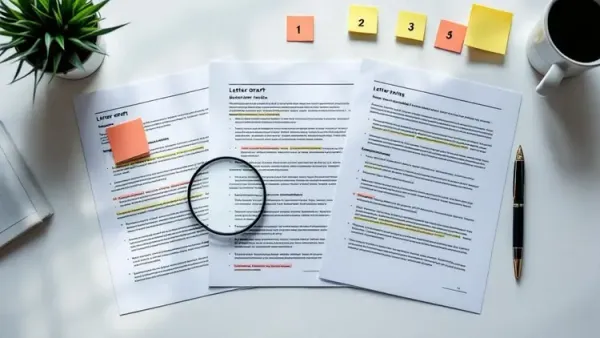Looking for effective ways to celebrate employee success? This listicle provides seven letter of recognition examples, covering various workplace scenarios. We'll analyze each example, highlighting key elements that make them impactful. You'll learn practical strategies to:
- Craft recognition letters that resonate with recipients
- Personalize your message for genuine appreciation
- Structure your letters for clarity and impact
- Use the right tone for each situation
Effective recognition boosts morale, improves retention, and drives performance. A thoughtfully written letter not only acknowledges achievement, but also reinforces desired behaviors and strengthens company culture. For more on the importance of positive reinforcement, consider the benefits of recognizing achievements. This article provides templates and actionable insights for writing impactful letters of recognition, specifically covering:
- Employee of the Month
- Years of Service
- Project Completion
- Customer Service Excellence
- Innovation and Improvement
- Team Leadership
- Safety and Compliance
Learn how to write recognition letters that genuinely make a difference. Mastering this skill contributes to a more engaged and productive workforce. These letter of recognition examples will equip you with the tools to effectively appreciate your team members and foster a thriving workplace.
1. Employee of the Month Recognition Letter
The Employee of the Month recognition letter is a powerful tool for acknowledging and celebrating an employee's exceptional contributions during a specific month. It goes beyond a simple "thank you" by highlighting specific achievements, demonstrating their impact, and reinforcing desired behaviors. This type of formal recognition boosts individual morale, motivates team members, and strengthens the overall company culture.

This recognition is particularly valuable because it publicly celebrates success and ties it to specific actions. This reinforces the link between effort and reward, inspiring other employees to strive for excellence. Learn more about boosting morale through staff appreciation. It also demonstrates the organization's commitment to recognizing and rewarding top performers.
Examples of Successful Implementation
- Sales Representative exceeding targets: A letter might detail how the employee exceeded their quarterly sales target by 150%, highlighting their strategic prospecting, effective closing techniques, and positive client relationships.
- Customer Service Agent with high satisfaction scores: Recognition could focus on consistently high customer satisfaction scores, demonstrating empathy, problem-solving skills, and going the extra mile to resolve customer issues.
- Team Leader managing successful project delivery: The letter might outline the team leader's effective project management, highlighting their communication, organization, and ability to motivate the team to deliver a critical project on time and within budget.
Actionable Tips for Writing Effective Letters
- Quantify achievements: Use specific numbers and metrics to demonstrate the impact of the employee's contributions (e.g., "increased sales by 20%," "reduced customer complaints by 15%").
- Showcase behavioral examples: Describe specific actions and behaviors that led to the employee's success (e.g., "proactively identified new sales opportunities," "implemented a new customer feedback system").
- Highlight the positive impact: Explain how the employee's contributions benefited the team, department, or company as a whole.
- Personalize the message: Go beyond generic praise and tailor the letter to the individual's specific accomplishments and contributions.
When and Why to Use Employee of the Month Recognition
- Consistent outstanding performance: Recognize employees who consistently go above and beyond their regular duties.
- Significant contributions to a project or goal: Acknowledge exceptional efforts that contribute to the success of a key initiative.
- Exemplary behavior and attitude: Reward employees who consistently demonstrate positive work ethic, teamwork, and a commitment to company values.
By following these tips and examples, you can create impactful Employee of the Month recognition letters that motivate employees, strengthen company culture, and drive positive business outcomes. Remember to distribute copies to HR and the employee's personnel file for documentation. Consider a public announcement or ceremony to amplify the recognition and further inspire others.
2. Years of Service Recognition Letter
The Years of Service Recognition Letter is a powerful way to acknowledge and celebrate an employee's dedication and loyalty to the organization. It commemorates significant milestones, such as 5, 10, 15, or 20+ years of service, and highlights the employee's journey, growth, and contributions over their tenure. This type of recognition reinforces company values, strengthens employee engagement, and fosters a sense of belonging within the organization.

This infographic illustrates the typical milestones celebrated in Years of Service awards, highlighting the progression from building a foundation of reliability in the first five years to demonstrating leadership and institutional knowledge after 15+ years. The visualization reinforces the value of long-term employees and their increasing contribution to the company over time.
Examples of Successful Implementation
- Manufacturing worker celebrating 25 years with a perfect safety record: The letter might detail their unwavering commitment to safety protocols, their role in mentoring new employees, and their consistent high-quality work.
- Administrative assistant reaching a 15-year milestone: Recognition could focus on their exceptional organizational skills, their ability to adapt to changing technologies, and their unwavering support to multiple departments.
- Manager completing 20 years with multiple promotions: The letter might outline their career progression within the company, highlighting their leadership development, their successful team management, and their contributions to key company initiatives.
Actionable Tips for Writing Effective Letters
- Research the employee's career progression: Review their personnel file and speak with their current and past managers to gain a comprehensive understanding of their contributions.
- Include personal anecdotes or memorable contributions: Add specific examples of their positive impact on the company, colleagues, or clients.
- Mention specific departments or roles they've held: Highlight their growth and development within the organization.
- Coordinate with HR for accurate service dates: Ensure accurate information regarding their start date and years of service.
When and Why to Use Years of Service Recognition
- Milestone anniversaries: Recognize employees reaching significant service anniversaries (e.g., 5, 10, 15, 20+ years).
- Celebrating long-term commitment and loyalty: Show appreciation for their dedication and contributions to the company's success.
- Reinforcing company values: Highlight how their tenure exemplifies the organization's values and culture.
By acknowledging and celebrating years of service, organizations can foster a sense of loyalty, strengthen employee engagement, and create a positive work environment. Distribute copies of the letter to HR and the employee's personnel file for documentation. Consider a public announcement, a small gift, or a celebratory event to amplify the recognition and further inspire others.
3. Project Completion Achievement Letter
The Project Completion Achievement Letter is a vital tool for recognizing employees' contributions to successful projects. It acknowledges their dedication, problem-solving skills, and the tangible impact of their work. This type of recognition fosters a sense of accomplishment, reinforces positive behaviors, and motivates employees to take on future challenges. It showcases the organization's appreciation for commitment to project goals and strengthens the link between effort and reward.

This recognition is especially powerful due to its focus on measurable results and the collaborative nature of projects. It highlights the direct impact of individual efforts on organizational success, promoting a culture of accountability and ownership. It also emphasizes the importance of teamwork in achieving ambitious goals.
Examples of Successful Implementation
- Software Implementation: A letter might detail how a team completed a complex software implementation under budget and ahead of schedule, highlighting their technical expertise, collaboration, and proactive problem-solving.
- Marketing Campaign Exceeding Targets: Recognition could focus on a marketing campaign that achieved 200% of its target engagement, showcasing the team's creativity, data-driven strategies, and effective communication.
- Construction Project with Zero Safety Incidents: The letter might acknowledge a construction project completed with zero safety incidents, emphasizing the team's commitment to safety protocols, meticulous planning, and proactive risk management.
Actionable Tips for Writing Effective Letters
- Include specific project metrics and KPIs: Quantify the project's success using data (e.g., "reduced costs by 15%," "increased efficiency by 20%").
- Acknowledge team members and collaboration: Recognize the contributions of all team members involved in the project.
- Mention challenges overcome during execution: Showcase the team's resilience and problem-solving abilities.
- Connect project success to broader organizational goals: Demonstrate how the project contributed to the overall success of the organization.
When and Why to Use Project Completion Achievement Recognition
- Successful completion of major projects: Recognize teams or individuals upon the successful delivery of significant projects.
- Achievement of key project milestones: Acknowledge progress and motivate teams to continue their efforts.
- Exemplary project management and execution: Reward teams that demonstrate exceptional planning, organization, and problem-solving.
By following these tips, you can create impactful Project Completion Achievement Letters that boost morale, reinforce positive behaviors, and encourage future project success. Distribute copies to HR and each team member's personnel file for documentation. Consider a team celebration or a public announcement to amplify the recognition.
4. Customer Service Excellence Recognition Letter
The Customer Service Excellence Recognition Letter is a vital tool for acknowledging and rewarding employees who consistently deliver outstanding customer service. It goes beyond a simple "thank you" by highlighting specific instances of exceptional service, demonstrating their impact on customer satisfaction, and reinforcing a customer-centric culture. This formal recognition significantly boosts individual morale, motivates team members, and strengthens the overall brand reputation.
This recognition is particularly valuable because it directly links positive customer experiences to specific employee actions. This reinforces the importance of customer-focused behaviors and inspires other employees to prioritize customer satisfaction. Learn more about creating a feedback culture in your workplace. It also publicly demonstrates the organization's commitment to valuing both its customers and the employees who serve them.
Examples of Successful Implementation
- Hotel Concierge with glowing reviews: A letter might include excerpts from multiple 5-star reviews praising the concierge's personalized recommendations, proactive assistance, and ability to create memorable guest experiences.
- Technical Support Agent resolving complex issues: Recognition could focus on an agent's efficiency in resolving technically challenging problems, highlighting their patience, clear communication, and ability to quickly identify and implement solutions.
- Retail Associate providing personalized solutions: The letter might detail how the associate went above and beyond to help a customer find the perfect product, demonstrating their product knowledge, attentiveness to customer needs, and commitment to exceeding expectations.
Actionable Tips for Writing Effective Letters
- Include direct quotes from customer feedback: Using the customer's own words adds authenticity and impact to the recognition.
- Mention specific service recovery situations: Highlighting how an employee successfully resolved a challenging customer situation demonstrates problem-solving skills and resilience.
- Highlight proactive rather than reactive service: Focus on instances where the employee anticipated customer needs and took initiative to provide exceptional service.
- Connect service excellence to business outcomes: Explain how the employee's actions contributed to customer retention, positive online reviews, or increased sales.
When and Why to Use Customer Service Excellence Recognition
- Consistently positive customer feedback: Recognize employees who regularly receive positive reviews and compliments from customers.
- Exceptional handling of challenging customer interactions: Acknowledge employees who demonstrate grace and professionalism in difficult situations.
- Proactive service that exceeds expectations: Reward employees who anticipate customer needs and go the extra mile to deliver outstanding service.
By following these tips and examples, you can create impactful Customer Service Excellence Recognition Letters that motivate employees, enhance the customer experience, and drive positive business results. Remember to distribute copies to HR and the employee's personnel file. A public announcement or internal newsletter feature can further amplify the recognition.
5. Innovation and Improvement Recognition Letter
The Innovation and Improvement Recognition Letter acknowledges employees who contribute innovative ideas, process improvements, cost-saving initiatives, or creative solutions that benefit the organization. It emphasizes forward-thinking, creativity, and the successful implementation of positive change. This type of recognition fosters a culture of continuous improvement and encourages employees to actively seek better ways of working.

Recognizing innovation is crucial for driving organizational growth and maintaining a competitive edge. It demonstrates that the company values creativity and initiative, inspiring others to think outside the box. These letters also highlight the tangible impact of these improvements, showcasing how individual contributions directly contribute to the company's success.
Examples of Successful Implementation
- Manufacturing Process Improvement: A letter might detail how an employee's process improvement in the manufacturing line saved $50,000 annually, specifically outlining the changes implemented and the resulting efficiency gains.
- Software Automation: Recognition could focus on an employee's software automation solution that reduced manual work by 40%, highlighting the time saved and the reduction in potential errors.
- Customer Experience Enhancement: The letter might showcase how an employee's innovative idea enhanced the customer experience, increasing customer satisfaction scores and strengthening customer loyalty.
Actionable Tips for Writing Effective Letters
- Quantify the Improvement Impact: Use specific metrics to demonstrate the tangible benefits of the innovation (e.g., "cost savings of $X," "time reduction of Y%," "increased efficiency by Z%").
- Explain the Innovation Process: Describe the thought process and steps taken to develop and implement the improvement.
- Mention Implementation Challenges Overcome: Highlight any obstacles encountered during implementation and how the employee successfully navigated them.
- Discuss Potential for Broader Application: Explore how the innovation could be applied to other areas of the organization to maximize its impact.
When and Why to Use Innovation and Improvement Recognition
- Successful implementation of a new idea: Recognize employees who successfully bring new ideas to fruition.
- Significant process improvements: Acknowledge efforts that lead to greater efficiency, cost savings, or quality enhancements.
- Creative solutions to challenging problems: Reward employees who demonstrate ingenuity and problem-solving skills.
By implementing these tips, organizations can create compelling Innovation and Improvement Recognition Letters that encourage a culture of creativity and continuous improvement. These letters reinforce the value of forward-thinking and contribute to a more dynamic and innovative workplace. Remember to distribute copies to HR and the employee's personnel file. Consider a public announcement during a team meeting to amplify the recognition.
6. Team Leadership Recognition Letter
The Team Leadership Recognition Letter acknowledges exceptional leadership qualities, team management skills, and the ability to inspire and guide others toward success. It goes beyond simply praising performance by highlighting the specific behaviors, strategies, and contributions that make a leader effective. This form of recognition not only boosts individual morale but also reinforces the importance of strong leadership within the organization. These letters focus on leadership behaviors, team development, and positive influence on organizational culture.
This recognition is particularly valuable because it reinforces the link between strong leadership and positive outcomes. It demonstrates the organization's commitment to developing and rewarding effective leaders, encouraging others to cultivate similar skills. It also provides a tangible record of the leader's contributions, supporting their professional growth and development.
Examples of Successful Implementation
- Team manager successfully leading through organizational change: A letter might detail how the manager effectively communicated changes, addressed team concerns, and facilitated a smooth transition during a company restructuring.
- Project leader developing junior staff while delivering results: Recognition could focus on the leader's mentorship of junior team members, highlighting their ability to delegate effectively, provide constructive feedback, and foster skill development while still achieving project objectives.
- Department head fostering inclusive and productive team culture: The letter might outline the leader's efforts in creating a positive and inclusive team environment, emphasizing their ability to promote collaboration, resolve conflicts, and build trust among team members.
Actionable Tips for Writing Effective Letters
- Include specific examples of leadership in action: Describe concrete situations where the leader demonstrated exceptional leadership skills (e.g., "Successfully navigated a complex project change request," "Resolved a team conflict that improved overall productivity").
- Mention team member feedback and development outcomes: Highlight positive feedback from team members and showcase how the leader's guidance contributed to individual or team growth.
- Highlight difficult situations handled with strong leadership: Describe instances where the leader effectively managed challenging situations, demonstrating resilience, problem-solving, and decision-making abilities.
- Connect leadership impact to organizational objectives: Explain how the leader's contributions have positively impacted broader organizational goals and objectives.
When and Why to Use Team Leadership Recognition
- Successful navigation of challenging situations: Recognize leaders who effectively guide their teams through difficult projects, organizational changes, or unexpected obstacles.
- Positive team performance and development: Acknowledge leaders who foster high-performing teams, promote individual growth, and create a positive team culture.
- Alignment with organizational values and leadership principles: Reward leaders who consistently demonstrate the company's core values and exemplify strong leadership principles. Learn more about team leadership development plans.
By following these tips and examples, you can create powerful Team Leadership Recognition Letters that motivate leaders, promote a culture of strong leadership, and drive organizational success. Distribute copies to HR and the leader's personnel file for documentation. A public acknowledgment can also be highly effective.
7. Safety and Compliance Recognition Letter
The Safety and Compliance Recognition Letter is a crucial tool for acknowledging employees who prioritize and champion workplace safety and regulatory adherence. It goes beyond a simple "thank you," specifically highlighting actions and behaviors that contribute to a safer and more compliant work environment. This formal recognition not only boosts individual morale but also reinforces the organization's commitment to safety and compliance, fostering a culture of responsibility. This is especially valuable in high-risk industries like manufacturing, construction, and healthcare.
This recognition publicly celebrates individuals who go above and beyond to maintain safety standards. By showcasing their achievements, it encourages similar behavior in other employees, strengthening the overall safety culture. Learn more about fostering a positive safety culture through psychological safety at work. This proactive approach minimizes incidents, protects employees, and ensures regulatory compliance.
Examples of Successful Implementation
- Construction worker completing 1,000 hours without safety incidents: A letter might detail the worker's consistent adherence to safety protocols, proactive hazard identification, and commitment to a safe worksite.
- Laboratory technician maintaining perfect compliance audit scores: Recognition could focus on the technician's meticulous record-keeping, adherence to standard operating procedures, and commitment to maintaining a compliant laboratory environment.
- Manufacturing team implementing a new safety protocol reducing injuries by 30%: The letter might outline the team's proactive approach to safety, highlighting their collaboration, problem-solving skills, and successful implementation of a new protocol that demonstrably reduced workplace injuries.
Actionable Tips for Writing Effective Letters
- Include specific safety metrics and timeframes: Quantify the employee's contributions to safety (e.g., "1,000 incident-free hours," "30% reduction in injuries").
- Mention safety training completed and certifications earned: Highlight the employee's commitment to professional development in safety.
- Highlight proactive safety behavior and awareness: Showcase instances where the employee went above and beyond to ensure a safe environment.
- Connect safety performance to overall operational excellence: Emphasize how safety contributes to the company's overall success.
When and Why to Use Safety and Compliance Recognition
- Consistent adherence to safety protocols: Recognize employees who consistently follow safety rules and regulations.
- Proactive identification and mitigation of safety hazards: Acknowledge employees who actively identify and address potential risks.
- Implementation of new safety procedures or improvements: Reward employees who contribute to enhancing workplace safety.
- Successful completion of safety training and certifications: Celebrate employees who invest in their safety knowledge and skills.
By following these tips and examples, you can create effective Safety and Compliance Recognition Letters that promote a culture of safety, reduce workplace incidents, and strengthen regulatory compliance. Distribute copies to HR and the employee's personnel file. A public announcement or safety meeting acknowledgment can further amplify the recognition and encourage others.
Recognition Letter Types Comparison
| Recognition Type | Implementation Complexity 🔄 | Resource Requirements ⚡ | Expected Outcomes 📊 | Ideal Use Cases 💡 | Key Advantages ⭐ |
|---|---|---|---|---|---|
| Employee of the Month Recognition | Moderate: requires monthly evaluations | Medium: time for fair selection and writing | Boosts morale, motivates, documents performance | Short-term performance & monthly achievements | Drives motivation, healthy competition, reinforces values |
| Years of Service Recognition | Low: milestone-based, periodic | Medium-High: tracking tenure & organizing | Builds loyalty, promotes retention | Celebrating long-term commitment | Strengthens loyalty, positive culture, encourages retention |
| Project Completion Achievement | High: detailed tracking of projects | High: requires project data and documentation | Reinforces goal achievement, supports career growth | Recognizing project success | Encourages excellence, concrete examples, career support |
| Customer Service Excellence | Moderate: depends on feedback collection | Medium: needs feedback systems & testimonials | Enhances customer-centric culture, motivates service improvement | Outstanding customer interaction | Builds confidence, promotes positive reputation |
| Innovation and Improvement | High: requires impact measurement | Medium-High: need to evaluate innovations | Encourages creativity, drives continuous improvement | Innovative solutions and process improvements | Stimulates creativity, recognizes intellectual contributions |
| Team Leadership Recognition | Moderate-High: subjective evaluation | Medium: gathering leadership examples | Develops leaders, supports succession planning | Exceptional team and leadership behaviors | Reinforces leadership, supports culture, career growth |
| Safety and Compliance Recognition | Moderate: ongoing monitoring required | Medium: needs safety data and documentation | Reinforces safety culture, reduces accidents | Safety-critical industries, protocol adherence | Promotes safety, compliance, operational excellence |
Inspiring Action: Putting Recognition into Practice
Throughout this article, we've explored seven letter of recognition examples, each designed for a specific workplace scenario. From celebrating an "Employee of the Month" to acknowledging years of dedicated service, these examples provide a strong foundation for building a culture of appreciation within your organization. We've also delved into the strategic "why" behind effective recognition, emphasizing the importance of personalized messaging and connecting individual achievements to broader company objectives. Remember, recognizing employees isn't just about handing out certificates; it's about fostering a sense of value and purpose.
Key Takeaways for Effective Recognition
Let's recap the most crucial takeaways for writing impactful letters of recognition:
- Personalization is Key: Generic letters lack impact. Tailor each letter to the specific individual and their accomplishments. Highlight their unique contributions and use specific anecdotes to illustrate their impact.
- Connect to Organizational Goals: Show employees how their individual efforts contribute to the bigger picture. This reinforces their sense of purpose and strengthens their connection to the organization.
- Be Timely and Specific: Recognize achievements promptly and detail the specific actions that deserve praise. This reinforces the value of those behaviors and encourages their repetition.
- Sincere and Authentic Tone: Genuine appreciation resonates far more than forced praise. Let your sincere gratitude shine through in your writing.
- Consider the Platform: A handwritten note can hold special significance, but digital platforms like Happily.ai offer streamlined tracking and a centralized hub for all recognition efforts.
Taking Your Recognition Efforts to the Next Level
Mastering these concepts is essential for any organization aiming to cultivate a thriving and engaged workforce. Effective employee recognition contributes to increased motivation, improved performance, and reduced turnover. It strengthens teams, fosters a positive work environment, and ultimately drives organizational success. By investing in meaningful recognition, you invest in the future of your company.
From Examples to Action: Building a Culture of Appreciation
Now is the time to translate these letter of recognition examples and strategic insights into actionable steps within your own organization. Start by identifying individuals who deserve recognition. Select the most appropriate template and personalize it with specific details. Consider the most impactful delivery method, whether it's a handwritten note, a company-wide email, or a presentation during a team meeting.
Streamline your recognition efforts and amplify their impact with Happily.ai. This platform provides a centralized system for tracking recognition, aligning individual achievements with company goals, and fostering a culture of appreciation. Visit Happily.ai to learn more and transform your recognition program today.









